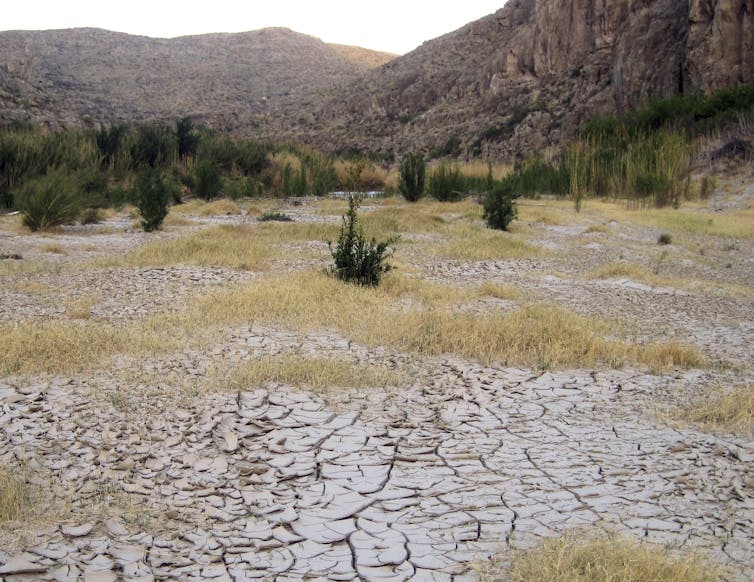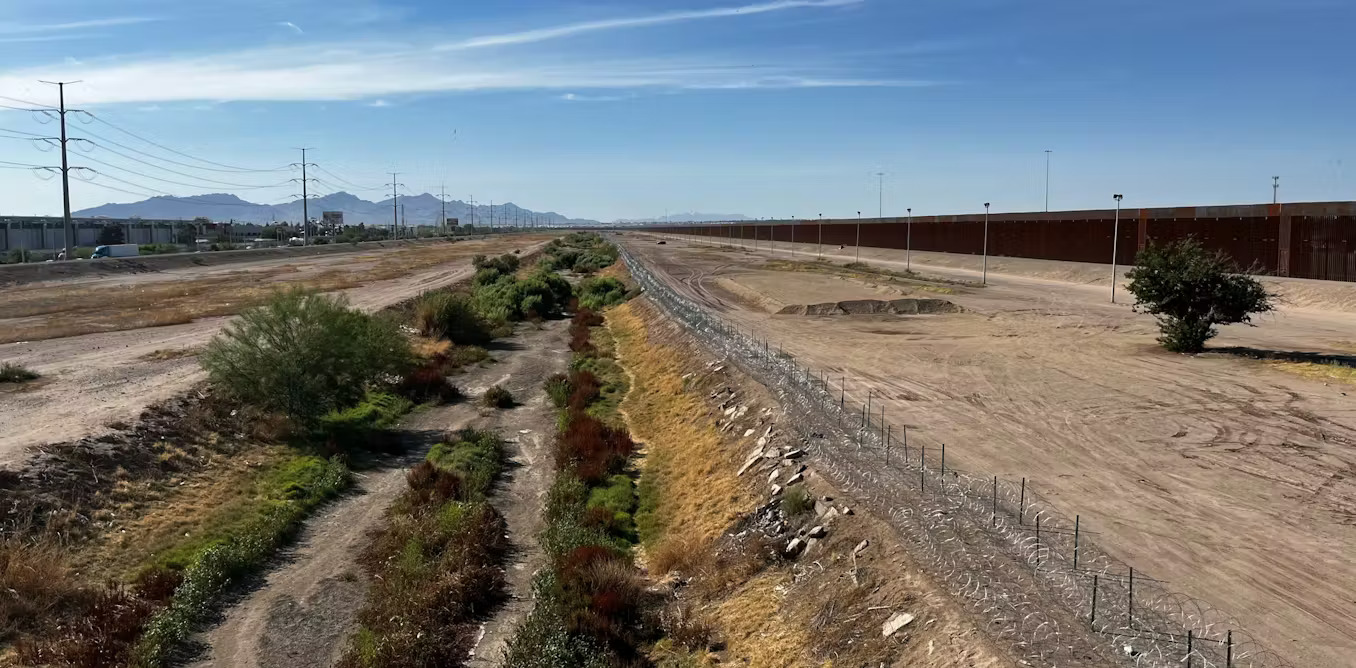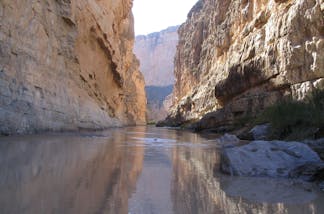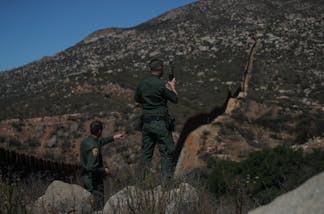The river’s English and Spanish names mean, respectively, “large” and “rough.” But viewed from the Zaragoza International Bridge, which connects the cities of El Paso, Texas, and Ciudad Juárez, México, what was once mighty is now a dry riverbed, lined ominously with barbed wire.

In the U.S., people often think of the Río Grande mainly as a political border that features in negotiations over immigration, narcotics smuggling and trade. But there’s another crisis on the river that receives far less attention. The river is in decline, suffering from overuse, drought and contentious water rights negotiations.
Urban and rural border communities with poor infrastructure, known in Spanish as colonias, are particularly vulnerable to the water crisis. Farmers and cities in southern Texas and northern México are also affected. As researchers who study hydrology and transboundary water management, we believe managing this important resource requires closer cooperation between the U.S. and México.
A hidden water crisis
For nearly 80 years, the U.S. and México have managed and distributed water from the Colorado River and the Lower Río Grande – from Fort Quitman, Texas, to the Gulf of México – under the 1944 Water Treaty, signed by presidents Franklin D. Roosevelt and Manuel Ávila Camacho. The Colorado River was the central focus of treaty negotiations because officials believed the Colorado basin would have more economic activity and population growth, so it would need more water. In fact, however, the Río Grande basin has also seen significant growth.
For the Río Grande, the treaty allocates specific shares of water to the U.S. and México from both the river’s main stem and its tributaries in Texas and México. Delivery of water from six Mexican tributaries has become the source of contention. One-third of this flow is allocated to the U.S., and must total some 76 million cubic feet (2.2 million cubic meters) over each five-year period.
The treaty allows México to roll any accrued deficits at the end of a five-year cycle over to the next cycle. Deficits can only be rolled over once, and they must be made up along with the required deliveries for the following five-year period.
–
These five-year periods, called cycles, are numbered. Cycles 25 (1992-1997) and 26 (1997-2002) were the first time that two consecutive cycles ended in deficit. Like the Colorado River, the Río Grande has become over-allocated: The 1944 treaty promises users more water than there is in the river. The main causes are persistent drought and increased water demand on both sides of the border.
Much of this demand was generated by the 1992 North American Free Trade Agreement, which eliminated most border tariffs between Canada, the U.S. and México. From 1993 through 2007, agricultural imports and exports between the U.S. and México quadrupled, and there was extensive expansion of maquiladoras – assembly plants along the border. This growth increased water demand.
Ultimately, México delivered more than the required amount for Cycle 27 (2002-2007), plus its incurred deficit from cycles 25 and 26, by transferring water from its reservoirs. This outcome appeased Texas users but left México vulnerable. Since then, México has continued to struggle to meet its treaty responsibilities and has experienced chronic water shortages.
In 2020, a confrontation erupted in the state of Chihuahua between the Mexican National Guard and farmers who believed delivery to Texas of water from the Río Conchos – one of the six tributaries regulated under the 1944 treaty – threatened their survival. In 2022, people lined up at water distribution sites in the Mexican city of Monterrey, where the population had doubled since 1990. As of 2023, halfway through Cycle 36, México has only delivered some 25% of its targeted amount.
Border politics overshadow water shortages
As climate change makes the Southwest hotter and drier, scientists predict that water shortages on the Río Grande will intensify. In this context, the 1944 treaty pits humanitarian needs for water in the U.S. against those in México.
It also pits the needs of different sectors against one another. Agriculture is the dominant water consumer in the region, followed by residential use. When there is a drought, however, the treaty prioritizes residential water use over agriculture.
The Río Grande is affected by nearly the same hydroclimate conditions as the Colorado River, which flows mainly through the southwest U.S. but ends in México. However, drought and water shortages in the Colorado River basin receive much more public attention than the same problems on the Río Grande. U.S. media outlets cover the Río Grande almost exclusively when it figures in stories about immigration and river crossings, such as Texas Gov. Greg Abbott’s 2023 decision to install floating barriers in the river at widely used crossing points.
The compact that governs use of Colorado River water has widely recognized flaws: The agreement is 100 years old, allocates more rights to water than the river holds, and completely excludes Native American tribes. However, negotiations over the Colorado between compact states and the U.S. and México are much more focused than decision-making about Río Grande water, which has to compete with many other bilateral issues.

Adapting to the future
As we see it, the 1944 water treaty is inadequate to solve the complex social, economic, hydrological and political challenges that exist today in the Río Grande basin. We believe it needs revision to reflect modern conditions.
This can be done through the minute process, which permits México and the U.S. to adopt legally binding amendments without having to renegotiate the entire agreement. The two countries have already used this process to update the treaty as it pertains to the Colorado River in 2012 and again in 2017.
These steps allowed the U.S. to adjust its deliveries of Colorado River water to México based on water levels in Lake Mead, the Colorado’s largest reservoir, in ways that proportionally distributed drought impacts between the two countries. In the Río Grande basin, México does not have similar flexibility.
The U.S. also has the ability to proportionally reduce deliveries under a separate 1906 agreement that outlines water delivery from El Paso to Ciudad Juárez. In 2013, for example, México received only 6% of the water it was due under the 1906 Convention.
Enabling México to proportionally reduce Río Grande deliveries according to drought conditions would distribute drought and climate change impacts more fairly between both countries. As we see it, this kind of cooperation would deliver human, ecological and political benefits in a complex and contentious region.
–
- Agriculture
- Climate change
- Drought
- Rivers
- Water shortage
- Water rights
- US-Mexico border
- North American Free Trade Agreement (NAFTA)
- Colorado River
- Rio Grande
- American Southwest
- US-Mexico relations
- Colorado River Compact
–
Authors Disclosure Statement
Vianey Rueda received funding through CUAHSI’s Instrumentation Discovery Travel Grant, which helps researchers learn about hydrologic instrumentation.
Drew Gronewold does not work for, consult, own shares in or receive funding from any company or organization that would benefit from this article, and has disclosed no relevant affiliations beyond his academic appointment.
Partners
University of Michigan provides funding as a founding partner of The Conversation US.
Republish our articles for free, online or in print, under a Creative Commons license.
–
Want to write?
Write an article and join a growing community of more than 172,600 academics and researchers from 4,770 institutions.














